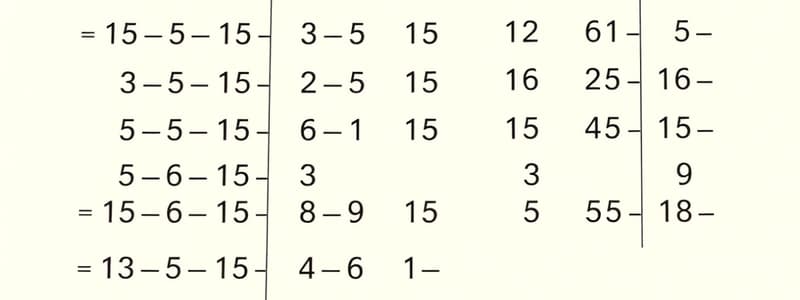Podcast
Questions and Answers
A company is trying to decide between two marketing strategies. Strategy A is projected to increase sales by 15% but has a higher initial cost. Strategy B is less expensive upfront but is only expected to increase sales by 10%. What additional information is MOST crucial for making a logical decision?
A company is trying to decide between two marketing strategies. Strategy A is projected to increase sales by 15% but has a higher initial cost. Strategy B is less expensive upfront but is only expected to increase sales by 10%. What additional information is MOST crucial for making a logical decision?
- The historical performance of the company's stock price over the past year.
- The color scheme of the marketing materials for each strategy.
- The number of employees who will be working on each marketing strategy.
- The exact initial cost of each strategy and the projected revenue increase from each. (correct)
A researcher is studying the effects of a new drug on reaction time. Participants are given the drug and then complete a reaction time test. The researcher observes a statistically significant decrease in reaction time among the participants who took the drug. What is the MOST significant potential confounding variable that the researcher should address?
A researcher is studying the effects of a new drug on reaction time. Participants are given the drug and then complete a reaction time test. The researcher observes a statistically significant decrease in reaction time among the participants who took the drug. What is the MOST significant potential confounding variable that the researcher should address?
- The time of day the test was administered. (correct)
- The brand of computer used for the reaction time test.
- The participants' favorite color.
- The participants' shoe size.
Premise 1: All dogs are mammals. Premise 2: All mammals are warm-blooded. Conclusion: Therefore, all dogs are warm-blooded. Which statement BEST describes the logical structure of this argument?
Premise 1: All dogs are mammals. Premise 2: All mammals are warm-blooded. Conclusion: Therefore, all dogs are warm-blooded. Which statement BEST describes the logical structure of this argument?
- It is an example of abductive reasoning.
- It is an example of inductive reasoning.
- It is a valid deductive argument. (correct)
- It is an invalid deductive argument.
A recent study found a strong correlation between ice cream sales and crime rates. Based solely on this information, which of the following conclusions is MOST justified?
A recent study found a strong correlation between ice cream sales and crime rates. Based solely on this information, which of the following conclusions is MOST justified?
A company decides to implement a new policy that allows employees to work from home two days a week. After three months, employee satisfaction has increased significantly. Which of the following is the MOST important factor to consider before concluding that the new policy caused the increase in satisfaction?
A company decides to implement a new policy that allows employees to work from home two days a week. After three months, employee satisfaction has increased significantly. Which of the following is the MOST important factor to consider before concluding that the new policy caused the increase in satisfaction?
Which of the following arguments commits the fallacy of affirming the consequent?
Which of the following arguments commits the fallacy of affirming the consequent?
A new fitness tracker boasts that it can accurately predict a user's calorie burn to within 50 calories per day. However, tests reveal that while the average prediction is accurate, individual predictions can vary by as much as 300 calories. Which statement BEST describes the tracker's accuracy?
A new fitness tracker boasts that it can accurately predict a user's calorie burn to within 50 calories per day. However, tests reveal that while the average prediction is accurate, individual predictions can vary by as much as 300 calories. Which statement BEST describes the tracker's accuracy?
A company is deciding where to locate a new factory. City A has lower labor costs but higher transportation costs. City B has higher labor costs but lower transportation costs. What information is MOST critical to determine the optimal location?
A company is deciding where to locate a new factory. City A has lower labor costs but higher transportation costs. City B has higher labor costs but lower transportation costs. What information is MOST critical to determine the optimal location?
A public health campaign aims to reduce smoking rates by showing graphic images of the health consequences of smoking on cigarette packs. After one year, smoking rates have decreased slightly, but sales of nicotine patches and gum have increased significantly. What is the MOST logical interpretation of these results?
A public health campaign aims to reduce smoking rates by showing graphic images of the health consequences of smoking on cigarette packs. After one year, smoking rates have decreased slightly, but sales of nicotine patches and gum have increased significantly. What is the MOST logical interpretation of these results?
A software company is testing two new algorithms for image recognition. Algorithm A correctly identifies 95% of images but has a 10% false positive rate (identifies something incorrectly). Algorithm B correctly identifies 90% of images but has a 2% false positive rate. Under what circumstance would Algorithm B be preferred over Algorithm A?
A software company is testing two new algorithms for image recognition. Algorithm A correctly identifies 95% of images but has a 10% false positive rate (identifies something incorrectly). Algorithm B correctly identifies 90% of images but has a 2% false positive rate. Under what circumstance would Algorithm B be preferred over Algorithm A?
Flashcards
Logical Reasoning Tests
Logical Reasoning Tests
Evaluates the capacity to understand complex data, spot patterns, and logically solve problems.
Aptitude Tests
Aptitude Tests
Tests that gauge specific cognitive capabilities like numerical, verbal, and spatial ability.
Numerical Reasoning
Numerical Reasoning
Involves interpreting data in tables and graphs, performing calculations like percentages and ratios.
Verbal Reasoning
Verbal Reasoning
Signup and view all the flashcards
Logical Reasoning
Logical Reasoning
Signup and view all the flashcards
Abstract Reasoning
Abstract Reasoning
Signup and view all the flashcards
Diagrammatic Reasoning
Diagrammatic Reasoning
Signup and view all the flashcards
Situational Judgement
Situational Judgement
Signup and view all the flashcards
Critical Thinking
Critical Thinking
Signup and view all the flashcards
Problem-Solving
Problem-Solving
Signup and view all the flashcards
Study Notes
- Aptitude and logical reasoning tests assess a candidate's ability to understand and interpret complex information, identify patterns, and solve problems logically.
- These tests are widely used in recruitment processes to evaluate a candidate's potential for success in a particular role.
- Aptitude tests measure specific cognitive abilities, such as numerical, verbal, and spatial reasoning.
- Logical reasoning tests evaluate the ability to draw logical conclusions from given information.
Numerical Reasoning
- Numerical reasoning tests involve interpreting data presented in tables, charts, and graphs.
- Questions typically require performing calculations, such as percentages, ratios, and statistical analysis.
- Key skills include understanding numerical relationships, identifying trends, and making accurate calculations under time constraints.
- Practice with a variety of numerical problems to improve speed and accuracy.
- Familiarize yourself with common types of charts and graphs, such as bar graphs, pie charts, and line graphs.
- Focus on understanding the question and identifying the relevant data before performing calculations.
Verbal Reasoning
- Verbal reasoning tests assess the ability to understand and analyze written information.
- Questions may involve identifying assumptions, drawing inferences, and evaluating arguments.
- Key skills include reading comprehension, critical thinking, and attention to detail.
- Enhance reading skills by practicing with complex texts and summarizing key points.
- Familiarize yourself with different types of arguments and logical fallacies.
- Pay close attention to the wording of questions and answer choices to avoid misinterpretations.
Logical Reasoning
- Logical reasoning tests evaluate the ability to draw logical conclusions from given premises.
- Questions may involve deductive reasoning, inductive reasoning, and abductive reasoning.
- Key skills include identifying patterns, recognizing relationships, and evaluating the validity of arguments.
- Practice with logic puzzles and brain teasers to improve problem-solving skills.
- Familiarize yourself with different types of logical arguments, such as syllogisms and conditional statements.
- Learn to identify common reasoning errors, such as affirming the consequent and denying the antecedent.
Abstract Reasoning
- Abstract reasoning tests assess the ability to identify patterns and relationships in abstract shapes and figures.
- Questions typically involve identifying the next figure in a sequence or the missing figure in a matrix.
- Key skills include visual perception, spatial reasoning, and inductive reasoning.
- Practice with a variety of abstract reasoning problems to improve pattern recognition skills.
- Look for common patterns, such as rotations, reflections, and translations.
- Pay attention to the details of the figures, such as the number of sides, angles, and colors.
Diagrammatic Reasoning
- Diagrammatic reasoning tests involve interpreting and manipulating diagrams to solve problems.
- Questions may involve flowcharts, Venn diagrams, and network diagrams.
- Key skills include spatial reasoning, logical reasoning, and problem-solving.
- Practice with a variety of diagrammatic reasoning problems to improve diagram interpretation skills.
- Learn to identify the key elements of a diagram and how they relate to each other.
- Use diagrams to visualize complex problems and develop logical solutions.
Situational Judgement
- Situational judgement tests assess how a candidate would respond to realistic work situations.
- Questions typically involve presenting a scenario and asking the candidate to choose the most appropriate course of action.
- Key skills include problem-solving, decision-making, and interpersonal skills.
- Consider the consequences of each course of action and choose the option that is most likely to lead to a positive outcome.
- Demonstrate an understanding of workplace ethics and professional standards.
- Seek feedback from others on your responses to situational judgement questions.
Critical Thinking
- Critical thinking is the ability to analyze information objectively and make reasoned judgments.
- Key skills include evaluating evidence, identifying assumptions, and drawing logical conclusions.
- Develop critical thinking skills by questioning assumptions and seeking out diverse perspectives.
- Practice evaluating the credibility of sources and identifying biases.
- Use critical thinking skills to solve problems and make decisions in both personal and professional contexts.
Problem-Solving
- Problem-solving is the process of identifying and resolving problems.
- Key skills include analyzing problems, developing solutions, and implementing solutions.
- Improve problem-solving skills by practicing with a variety of problems and learning different problem-solving techniques.
- Break down complex problems into smaller, more manageable parts.
- Evaluate the effectiveness of solutions and make adjustments as needed.
General Tips
- Read the instructions carefully before starting each test.
- Manage your time effectively and allocate enough time to each question.
- Don't spend too much time on any one question; if you're stuck, move on and come back to it later.
- Eliminate obviously wrong answers to narrow down your choices.
- Use a process of elimination to identify the correct answer.
- Check your answers carefully before submitting the test.
- Practice regularly to improve your speed and accuracy.
- Get enough rest before the test to ensure you are alert and focused.
- Stay calm and confident during the test.
Studying That Suits You
Use AI to generate personalized quizzes and flashcards to suit your learning preferences.




